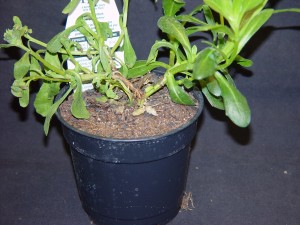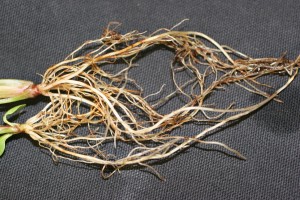Rhizoctonia solani
Pathogen: Rhizoctonia solani
Hosts Include: Achillea, Aconitum, Aquilegia, Aster, Campanula, Chyrsanthemum, Coreopsis, Delphinium, Dianthus, Digitalis, Gaillardia, Gypsophila, Helianthus, Hemerocallis, Hosta, Iberis, Lathyrus, Lilium, Limonium, Lysimachia, Nepeta, Oenother, Papaver, Phlox, Platycodon, Potentilla, Primula, Salvia, Sedum, Veronica, and Viola.
Symptoms: Rhizoctonia causes a variety of symptoms including damping off, stem lesions, stem rot, root rot, crown rot, and aerial web blighting. Infection causes wilting, stunting and possibly plant death. Some vegetatively propagated plants are susceptible to rot at the base of the cutting.
Spread: This is a soil borne pathogen, it persists in soil as mycelium and sclerotia (small, brown, long-term survival structures). The disease is spread by the movement of contaminated soil, plant material, tools and equipment.
Management: Good sanitation practices are important to minimize disease introduction and spread. Rhizoctonia spp. tend to be more prevalent on stressed or wounded plants. Stress factors such as excess or deficiency of water and fertilizer are important considerations in preventing Rhizoctonia diseases. Avoid periods of wet conditions followed by dry conditions. The fungus is favored by warm moist conditions. Severely affected plants should be removed promptly. Research on efficacy of biological control through soil amendments is ongoing.






 Print
Print Email
Email




